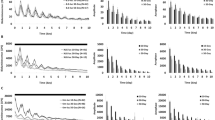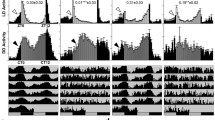Abstract
A diverse range of organisms shows physiological and behavioural rhythms with various periods. Extensive studies have been performed to elucidate the molecular mechanisms of circadian rhythms with an approximately 24 h period in both Drosophila and mammals, while less attention has been paid to ultradian rhythms with shorter periods. We used a video-tracking method to monitor the movement of single flies, and clear ultradian rhythms were detected in the locomotor behaviour of wild type and clock mutant flies kept under constant dark conditions. In particular, the Pigment-dispersing factor mutant (Pdf 01) demonstrated a precise and robust ultradian rhythmicity, which was not temperature compensated. Our results suggest that Drosophila has an endogenous ultradian oscillator that is masked by circadian rhythmic behaviours.







Similar content being viewed by others
References
Albers H, Gerall AA and Axelson JF 1981 Circadian rhythm dissociation in the rat: Effects of long-term constant illumination. Neurosci. Lett. 25 89–94
Barrio R, Zhang L and Maini P 1997 Hierarchically coupled ultradian oscillators generating robust circadian rhythms. Bull. Math. Biol. 59 517–532
Bracic M 1998 Wavelet-based analysis of human blood-flow dynamics. Bull. Math. Biol. 60 919–935
Chung BY, Kilman VL, Keath JR, Pitman JL and Allada R 2009 The GABAA receptor RDL acts in peptidergic PDF neurons to promote sleep in Drosophila. Curr. Biol. 19 386–390
Corner MA (1977) Sleep and the beginnings of behavior in the animal kingdom--Studies of ultradian motility cycles in early life. Prog Neurobiol. 8 279–295
Dowse H and Ringo J 1987 Further evidence that the circadian clock in Drosophila is a population of coupled ultradian oscillators. J. Biol. Rhythms. 2 65–76
Dowse HB, Hall JC and Ringo JM 1987 Circadian and ultradian rhythms in period mutants of Drosophila melanogaster. Behav. Genet. 17 19–35
Dowse HB and Ringo JM 1989 The search for hidden periodicities in biological time series revisited. J. Theor. Biol. 139 487–515
Hall JC 2005 Systems approaches to biological rhythms in Drosophila in circadian rhythms. Methods. Enzymol. 393 61–185
Hochachka PW and Guppy M 1987 Metabolic arrest and the control of biological time (Harvard University Press)
Ichikawa T 2009 Partial synchronization dynamics of coupled ultradian oscillators comprising an insect neurosecretory cell system. Zoolog. Sci. 26 861–869
Kahsai L, Martin J and Winther AME 2010 Neuropeptides in the Drosophila central complex in modulation of locomotor behavior. J. Exp. Biol. 213 2256–2265
Kyriacou CP and Hall JC 1980 Circadian rhythm mutations in Drosophila melanogaster affect short-term fluctuations in the male's courtship song. Proc. Natl. Acad. Sci. USA 77 6729–6733
Levine J Funes P Dowse H and Hall J 2002 Signal analysis of behavioral and molecular cycles. BMC Neurosci. 3 1–25
Lloyd D and Rossi EL 2008 Ultradian rhythms from molecules to mind (Springer)
Mertens I, Vandingenen A, Johnson EC, Shafer OT, Li W, Trigg J, De Loof A, Schoofs L, et al. 2005 PDF receptor signaling in Drosophila contributes to both circadian and geotactic behaviors. Neuron 48 213–219
Ohtomo N, Kamo T, Watanabe M, Yoneyama K, Tanaka Y and Hayashi R 1996a Power spectral densities of temporal variations of blood pressures. Jpn. J. Appl. Phys. 35 5571–5582
Ohtomo N, Sumi A, Tanaka Y, Tokiwano K and Terachi S 1996b A detailed study of power spectral density for rossler system. J. Phys. Soc. Jpn. 65 2811–2823
Ohtomo N, Terachi S, Tanaka Y, Tokiwano K and Kaneko N 1994 New method of time series analysis and its application to wolf's sunspot number data. Jpn. J. Appl. Phys. 33 2821–2831
Ohtomo N, Tokiwano K, Tanaka Y, Sumi A, Terachi S and Konno H 1995 Exponential characteristics of power spectral eensities caused by chaotic phenomena. J. Phys. Soc. Jpn. 64 1104–1113
Paetkau V, Edwards R and Illner R 2006 A model for generating circadian rhythm by coupling ultradian oscillators. Theor. Biol. Med. Model. 3 12–22
Power JM, Ringo JM and Dowse HB 1995 The effects of Period mutations and light on the activity rhythms of Drosophila melanogaster. J. Biol. Rhythms. 10 267–280
Price TS, Baggs JE, Curtis AM, FitzGerald GA and Hogenesch JB 2008 WAVECLOCK: wavelet analysis of circadian oscillation. Bioinformatics 24 2794–2795
Rapp PE 1979 An atlas of cellular oscillators. J. Exp. Biol. 81 281–306
Rensing L, Meyer-Grahle U and Ruoff P 2001 Biological timing and the clock metaphor: oscillatory and hourglass mechanisms. Chronobiol. Int. 18 329–369
Rusak B and Zucker I 1975 Biological rhythms and animal behavior. Annu. Rev. Psychol. 26 137-171
Sawada Y, Ohtomo N, Tanaka Y, Tanaka G, Yamakoshi K, Terachi S, Shimamoto K, Nakagawa M, et al. 1997 New technique for time series analysis combining the maximum entropy method and non-linear least squares method: its value in heart rate variability analysis. Med. Biol. Eng. Comput. 35 318–322
Sumi A, Ohtomo N and Tanaka Y 1997a Study on chaotic characteristics of incidence data of measles. Jpn. J. Appl. Phys. 36 7460–7472
Sumi A, Ohtomo N, Tanaka Y, Koyama A and Saito K 1997b Comprehensive spectral analysis of time series data of recurrent epidemics. Jpn. J. Appl. Phys. 36 1303–1318
Tomioka K, Sakamoto M, Harui Y, Matsumoto N and Matsumoto A 1998 Light and temperature cooperate to regulate the circadian locomotor rhythm of wild type and period mutants of Drosophila melanogaster. J. Insect. Physiol. 44 587–596
Wollnik F 1989 Physiology and regulation of biological rhythms in laboratory animals: an overview. Lab. Anim. 23 107–125
Xu K Zheng X and Sehgal A 2008 Regulation of feeding and metabolism by neuronal and peripheral clocks in Drosophila. Cell. Metab. 8 289–300
Yamaguchi S Desplan C and Heisenberg M 2010 Contribution of photoreceptor subtypes to spectral wavelength preference in Drosophila. Proc. Natl. Acad. Sci. USA 107 5634–5639
Zimmerman JE, Raizen DM, Maycock MH, Maislin G and Pack AI 2008 A video method to study Drosophila sleep. Sleep 31 1587–1598
Acknowledgements
We thank the Bloomington Drosophila Stock Center, M Rosbash, JC Hall, and MW Young for fly strains. We also thank Kiyo Kimura and Kyoko Sakamoto for technical help. This work was supported by a grant from the Ministry of Education, Culture, Sports, Science and Technology of Japan and a grant from the Naito Foundation, Japan to TT. I would like to dedicate this paper to the memory of Dr Obaid Siddiqi. We walked along the neurogenetics research of Drosophila for the past years in India and Japan.
Author information
Authors and Affiliations
Corresponding author
Additional information
[Seki Y and Tanimura T 2014 Ultradian rhythm unmasked in the Pdf clock mutant of Drosophila. J. Biosci. 39 1–10] DOI 10.1007/s12038-014-9450-z
Supplementary materials pertaining to this article are available on the Journal of Biosciences Website at http://www.ias.ac.in/jbiosci/sep2014/supp/Seki.pdf
Electronic supplementary material
Below is the link to the electronic supplementary material.
ESM 1
(PDF 36.1 mb)
Rights and permissions
About this article
Cite this article
Seki, Y., Tanimura, T. Ultradian rhythm unmasked in the Pdf clock mutant of Drosophila . J Biosci 39, 585–594 (2014). https://doi.org/10.1007/s12038-014-9450-z
Published:
Issue Date:
DOI: https://doi.org/10.1007/s12038-014-9450-z




